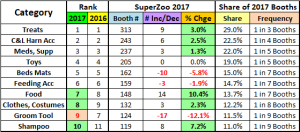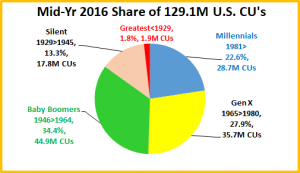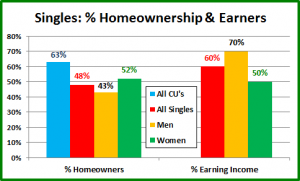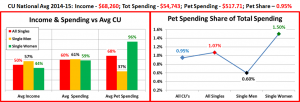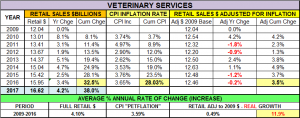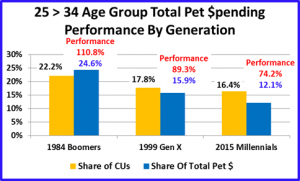Price Matters: Petflation Update – Current Trends…Plus a Look Back
Price has always mattered but it has truly come to the forefront in the consumers’ mind since the great recession. In this report we will review the latest “Petflation” trends for all industry segments but we will also take a look back in time 10 years to 2007, before the economic crisis struck. Let’s see what has changed and how we got to where we are today.
The following chart graphically shows the annual CPI change from 2007 to today – Ytd May of 2017.
- The first thing that you notice is that since 2009 the Supply Segment has travelled to the beat of a different drummer. Prices are only 0.8% higher now than in 2007. In fact, prices now are almost exactly equal to August 2007.
- The period from 2007 to 2009 was a strong economic time. Prices in all segments just went up, like clockwork. With a 20.5% increase in 2 years, Pet Food was “leading the pack”. There is a story behind this. As a result of the melamine recall of 2007, U.S. consumers became concerned over Pet Food Safety. They moved strongly toward U.S. made Pet Foods, with all U.S. ingredients. These products cost more to produce and drove the overall price of Pet Food up – significantly. Although the 6% increase in 2 years for Supplies may seem tame in comparison, it was triple the segment’s annual rate of increase for the earlier years in the century.
- The revenue growth in the industry for these years was primarily due to increased prices.
- Then came the great recession. Most industries felt the impact on prices in 2009, with a drop in the national CPI for the first time since 1955. (The recession was a big deal!) However, prices in the Pet Industry weren’t affected until 2010. Prices fell in both Food and supplies and the increase in Non-Vet Services was slowed. Prices in the Veterinary segment were unaffected. They just kept going up at the same rate.
- From 2010 to 2013, prices in all segments but supplies increased, but at a slower rate than the “pre-recession” time. Supplies was a completely different story. There are a variety of Supplies categories. Many are considered discretionary spending and have relatively low usage rates. With the consumers’ new shopping priorities – Price is #1, many supplies categories began to be looked upon as commodities and sales became very price sensitive. The initial price drop of 2010 was followed by an even bigger drop in 2013. Obviously, new rules applied to Supplies.
- With lower inflation rates in this period, more of the industry’s growth was real.
- From 2013 to 2016, prices in both of the Service segments continued to inflate – the Veterinary segment at 3.5% per year and Services at 2.4%. Revenue in the Service segment was unaffected, but the Veterinary Segment saw all growth coming from price increases. The amount of Vet Services provided in 2015 was actually about equal to 2010 – they just cost more.
- From 2013 to 2016 – Pet Food prices began to fall. It had become a more competitive environment in this segment. Food sales usually tend to stagnate when prices fall. Consumers don’t buy more food. They just spend less. However, in this case, we were on the edge of a change in food buying behavior. During the second half of 2014, the older Millennials began to try the new classification of foods, dubbed Super Premium. In early 2015 they backed away from this experiment but another group caught the fever – The Boomers. They went for these new, nutritionally concentrated, pet foods in a big way, over a $5.8B increase in spending. However, overall Food prices continued down as the manufacturers of “regular” recipes tried to “buy back” their lost customers.
- In 2013 and 2014 – Supply Prices dropped sharply. By 2014, this had caught the consumers’ attention and Supply sales moved up strongly. Then prices stabilized and began to move up. Apparently, the price sensitivity in Supplies had become very pronounced. In 2015 Consumers decreased their frequency of purchases by 10% and sales fell about $2B. Prices stabilized in 2016 but still moved up slightly.
As you can see, in the Post-Recession world, price can make a huge difference in consumer spending behavior. Now let’s take a closer look at the recent history of “Petflation”. The following chart documents the monthly change in CPI by Industry segment over the last 24 months, from May of 2015 through May of 2017.
- Total Pet – Prices in Total Pet increased 1.71% in 2 years, an annual rate of inflation under 1%, which is low. It was produced by a very reasonable 1.49% increase in the first half followed by a dramatically low increase of only 0.22% in the second 12 months. The 0.22% increase is the lowest 12 month inflation rate for Total Pet since they began keeping records back in 1997. This CPI history also clearly demonstrates that you should always look beneath the surface of any summary numbers. The individual parts can tell a very different story from the total.
- Veterinary – The first half was “business as usual” or even stronger, with a 3.97% increase in prices. However, there was a distinct change in the second 12 months. Prices only went up 1.8% and included a rare one month price drop of almost 1%. Perhaps, this segment is starting to react to a decrease in frequency of consumer visits.
- Service – The Service segment has a pattern somewhat similar to Veterinary. Prices were up a “normal” 2.25% in the first 12 months. In the second half prices only increased 0.6% and there were 3 monthly price drops, including a 0.7% drop in May ‘17. It’s possible that this discretionary segment is starting to experience competitive pressure.
- Pet Products – There is one situation of note that applies to both Food and Supplies. The annual CPI numbers can give the impression of a smooth increase or decrease. In the last few years, the norm for these two segments has been wild short term swings in prices. You can see examples of this for both categories in the first 8 months of the graphs. There have still been ups and downs but since January of 2016 the changes have been less radical.
- Pet Food – As we said, in 2015 the Boomers moved to upgrade their food to Super Premium. This chart shows how strongly the regular brands reacted – with over a 2% overall drop in prices in just 2 months – July and August 2015. The prices gradually worked their way back up to more normal levels by year end. However, another drop began in late summer of 2016. So far the prices have not recovered. One possibility is that even the high end products are now experiencing competitive pressure. Consider this fact. In 2015 there were 108 exhibitors selling Dog and/or Cat Food at SuperZoo. In 2017, just 2 years later, there were 147 – a 36% increase. If you have a good idea, others will try to get a piece of the action.
- Pet Supplies – Prices were up for most of 2015 and sales were down over a billion dollars. As we approached the prime holiday season, retailers reacted and prices fell almost 2%. It was not enough. The CPI only showed a slight overall increase for the year but sales fell by $2B. Prices moved back up to at or near previous levels and stayed there until the fall of 2016. They have generally moved down since then. The Supplies CPI actually has been relatively stable for 20 months now. We will have to wait and see how this affects consumer spending in this segment. The USBLS’ spending numbers for 2016 will be available in September.
In the past 24 months we have 2 trends that may have long term significance.
- The high inflation rate in both Service Segments has slowed in the past 12 months.
- Although both the CPI for Food and Supplies are trending down slightly, they have become more stable. They still have monthly variations but the pricing swings are less severe.
Thus far, we have focused solely on the CPIs for the Pet Industry. Let’s see how they compare over time to the National CPI and other relative industries. The final chart compares the CPI change from 2009, a pivotal year, to May of 2017.
- The annual inflation rate of Total Pet is only 1.42% – 23% lower than the overall national CPI. However, we know that the story behind the Total Pet number is not quite as rosy as it seems to be.
- The inflation rate for Pet Food is less than half that of Food & Beverages. There have been big pricing swings in Pet Food and the segment has been in deflation since 2013.
- The deflation in Supplies is both unusual and concerning because it puts strong profit pressure on manufacturers and retailers.
- Even with the recent slowing of inflation in the Veterinary segment, prices have increased 13.1% faster than Human Medical care. The consumer impact is magnified because Pet Insurance is not as effective as Human healthcare policies in lowering out of pocket expenses. Plus, the participation percentage is far lower.
- The inflation rate for the Service Segment has remained relatively constant over this time frame with little to no impact on revenue – so far.
That wraps it up for this Petflation update. We’ll check again when the Spending numbers for 2016 are released.








